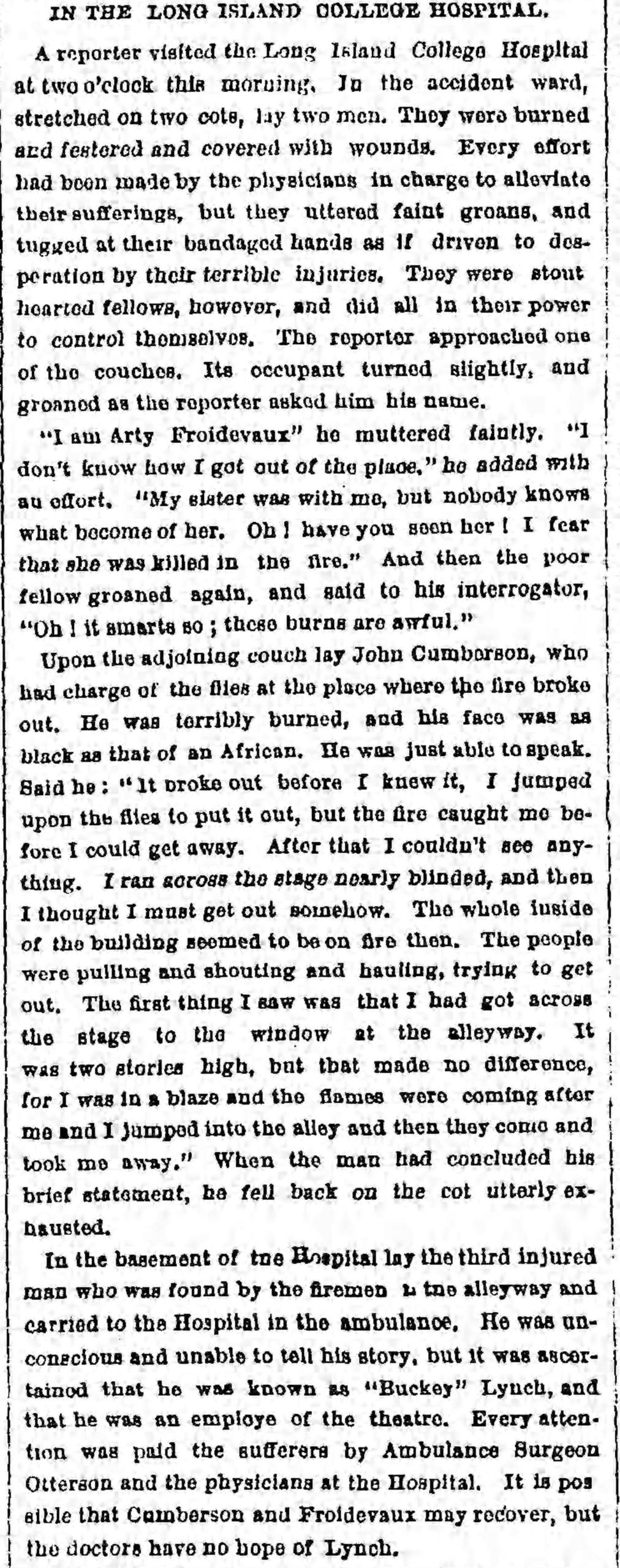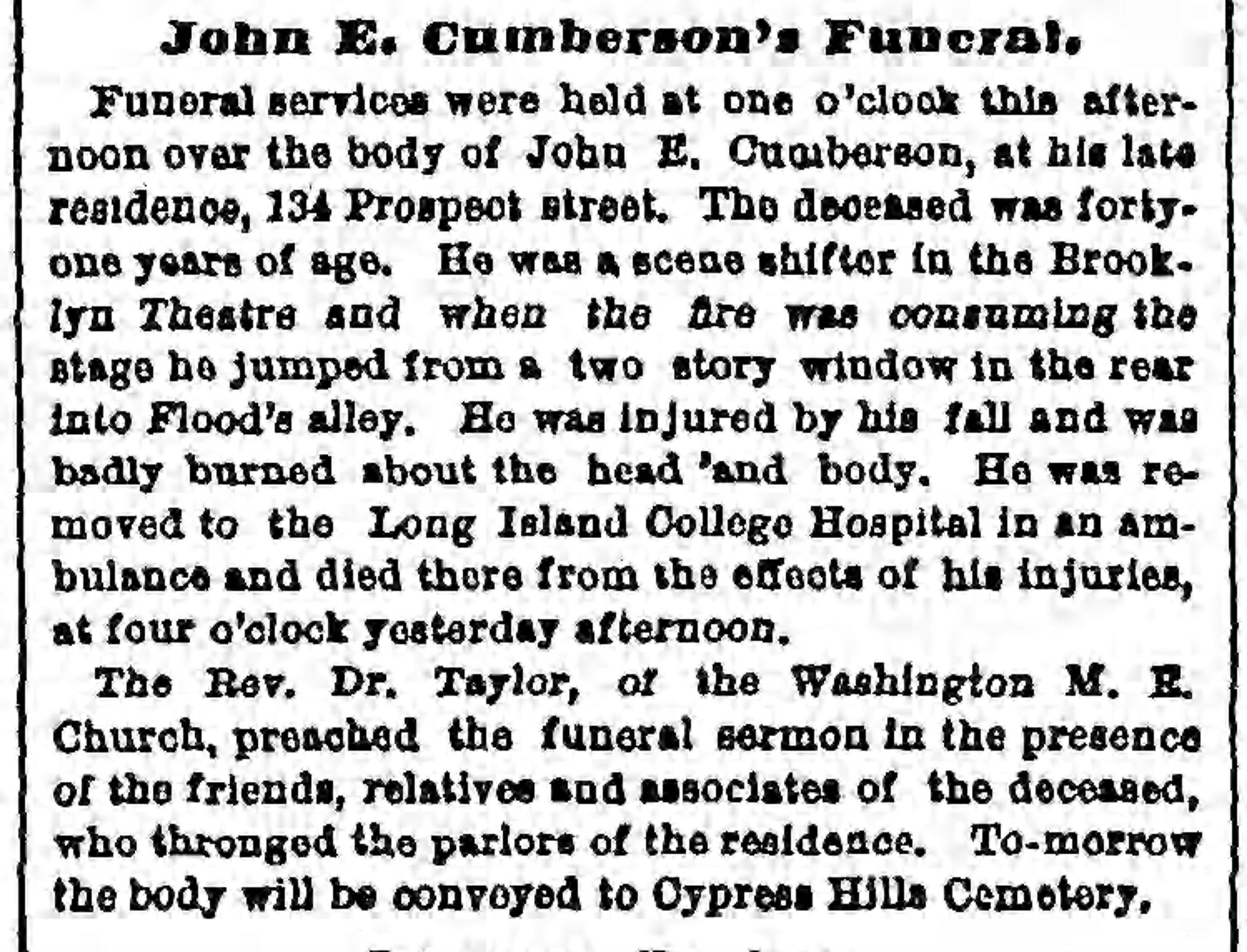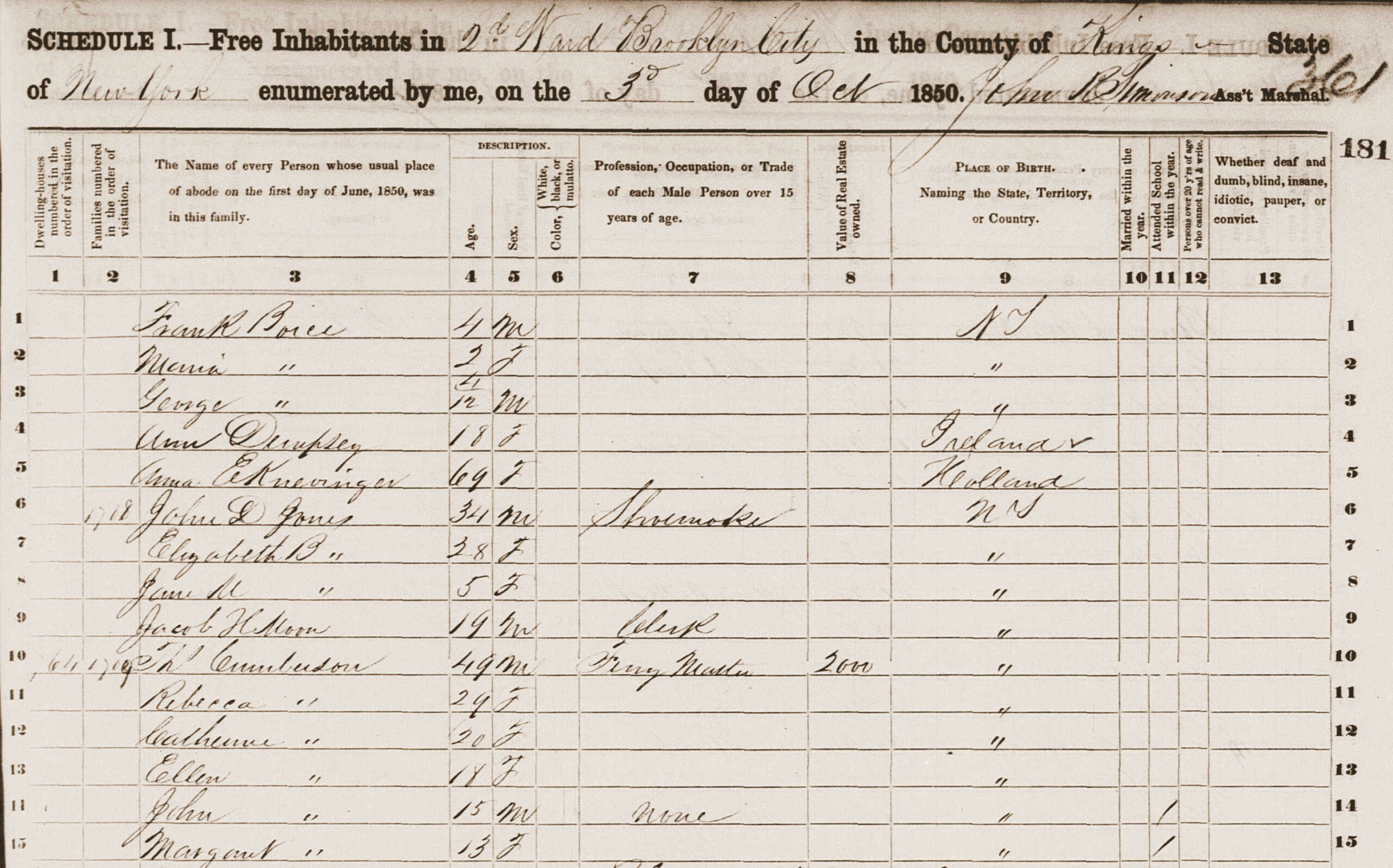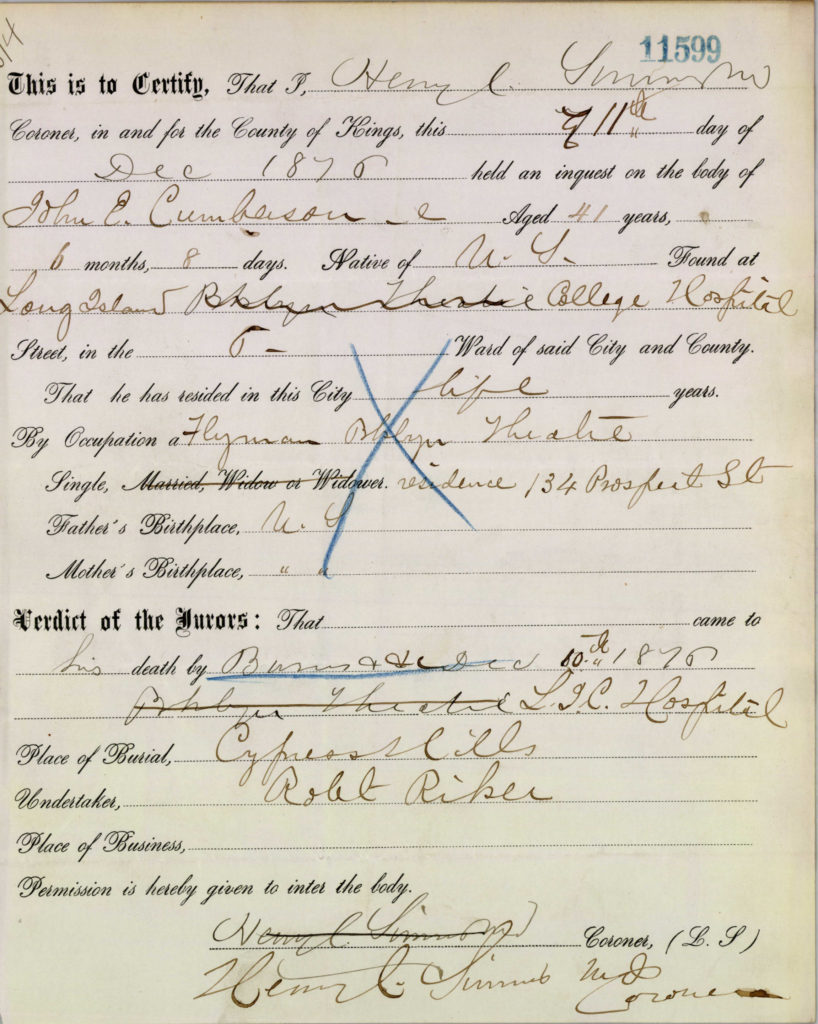
John E. Cumberson
His name appeared on a short list of “the injured persons who escaped with their lives” that was published in the December 6, 1876 issue of the Eagle. In the same issue, we read the following account of Cumberson’s condition:
IN THE LONG ISLAND COLLEGE HOSPITAL.
A reporter visited the Long Island College Hospital at two o’clock this morning. In the accident ward, stretched on two cots, lay two men. They were burned and festered and covered with wounds. Every effort had been made by the physicians in charge to alleviate their sufferings, but they uttered faint groans, and tugged at their bandaged hands as if driven to desperation by their terrible injuries. They were stout hearted fellows, however, and did all in their power to control themselves. The reporter approached one of the couches. Its occupant turned slightly, and groaned as the reporter asked him his name.
“I am Arty Froidevaux” he muttered faintly. “I don’t know how I got out of the place,” he added with an effort. “My sister was with me, but nobody knows what become of her. Oh! have you seen her! I fear that she was killed in the fire.” And then the poor fellow groaned again, and said to his interrogator, “Oh! it smarts so; these burns are awful.”
Upon the adjoining couch lay John Cumberson, who had charge of the flies at the place where the fire broke out. He was terribly burned, and his face was as black as that of an African. He was just able to speak. Said he: “It broke out before I knew it, I jumped upon the flies to put it out, but the fire caught me before I could get away. After that I couldn’t see anything. I ran across the stage nearly blinded, and then I thought I must get out somehow. The whole inside of the building seemed to be on fire then. The people were pulling and shouting and hauling, trying to get out. The first thing I saw was that I had got across the stage to the window at the alleyway. It was two stories high, but that made no difference, for I was in a blaze and the flames were coming after me and I jumped into the alley and then they come and took me away.” When the man had concluded his brief statement, he fell back on the cot utterly exhausted.
The reporter concluded that “It is possible that Cumberson and Froidevaux may recover,” but we now know that only Arty survived the fire. Six days later, Cumberson’s obituary was published in the Eagle.

John E. Cumberson’s Funeral.
Funeral services were held at one o’clock this afternoon over the body of John E. Cumberson, at his late residence, 134 Prospect street. The deceased was forty-one years of age. He was a scene shifter in the Brooklyn Theatre and when the fire was consuming the stage he jumped from a two story window in the rear into Flood’s alley. He was injured by his fall and was badly burned about the head and body. He was removed to the Long Island College Hospital in an ambulance and died there from the effects of his injuries, at four o’clock yesterday afternoon.
The Rev. Dr. Taylor, of the Washington M.E. Church, preached the funeral sermon in the presence of the friends, relatives and associates of the deceased, who thronged the parlors of the residence. To-morrow the body will be conveyed to Cypress Hills Cemetery.

Before his demise, Cumberson gave description of events leading up to his escape from the Brooklyn Theater; this was recorded by Fire Marshal Keady and published in the Eagle on December 11, 1876.
John E. Cumberson’s Statement
John Cumberson, the flyman of the Brooklyn Theatre, died at the Long Island College Hospital yesterday afternoon from the injuries received during his escape from the burning pile. Late on Saturday night the Fire Marshal took the dying man’s statement, which was as follows:
I live at No. 134 Prospect street; I was employed in the Brooklyn Theatre and had charge of the flies; I was in the theatre on the night of the fire and saw the fire break out; the fire commenced in the centre of the building, in the rigging loft, among the borders or drop curtains; I think the draft brought the border in contact with the back of the light; there were wire coverings over the lights, but they are not always regular; the wires were close enough, we thought, to prevent the border from touching the light; the borders did not get out of order in any way; they went up right enough, but when I came to let them down they dragged; I tried to put the green curtain down and then she broke; nothing broke before the fire; this was the commencement of the trouble; we had some few places of the scenery of “Julius Caesar” on the stage that night; I was unfastening the grooves when one of the men went out to put the fire out with a pole, but could not do it; we had no fire hose, attached or otherwise; I saw fire hydrants in the building, down under and on the stage, but no hose; I was there with Mrs. Conway three or four years, and she kept fire hose there, and always kept ails full of water to be used in case of fire; I never received any instructions from Messrs. Shook & Palmer or Mr. Thorpe about fire; we had two other fires in the theatre shortly before this last one; one of them was in a curtain in the box office, and the other was on the stage; I did not see either of them; they occurred about six weeks ago; I cannot say that they were reported to the police; I [think] the doors leading to Johnson street were all clear on the stage; I do not think the border lights were as well protected as the border lights in other theatres, they were too flimsy for me; they looked as if they wanted new “knitting;” the alarm was given the police pretty soon after the fire was discovered; the audience were not notified of it for three or four minutes; I kept the curtain down as long as I could; I did not see any fire hose, new or old, in this building; we had no apparatus of any kind for putting out fires, except the stationary hydrants; no, sir! no, sir! no, sir! we never had a fire in Mrs. Conway’s time; in going down I found I stayed longer than I should have done and could not get out on the landing. I met Mr. Murdoch and he went right up to his room; I saw him drop from the heat and smoke; he looked to me as if he was going out on the roof; I jumped out of a window on Flood’s alley, leading from the first landing; Mr. Murdoch and Mr. Burroughs first went down on the stage to get out, and when they found the heat too great they went up stairs again; the other stage hands got out by the back door on Johnson street, and we were on the other side of the stage and could not reach that door; I do not think Murdoch or Burroughs tried to get out through the auditorium; if I had had a fire hose or water on the stage or on the flies I could have put out the fire before it gained such headway; it blazed up very rapidly; my man, Bill Layton, saw it first, and said, “I think that is a fire;” this was the first I saw of it.
His
John X Cumberson.
mark.
Sworn to before me this 9th day of December, 1876.
Patrick Keady, Fire Marshal.
John E. Cumberson was born on May 27, 1835 in Brooklyn to Thomas and Rebecca. The only son, he was one of the four children born to the Cumbersons. His elder sisters, Catherine and Ellen, were born in 1830 and 1832, respectively, and his younger sister, Margaret, was born in 1837. The earliest record which mentions John and his family is the Seventh census of the United States, which was conducted in 1850. The Cumberson family were living in the second ward of Brooklyn when the census was enumerated. At the time, John’s father was listed as Ferry Master with his real estate valued at $2000.


Name: John E. Cumbersome
Age: 41 years 6 months 8 days
Native of: U.S.
Resident of this City: life
Occupation: flyman Brooklyn Theatre
Marital Status: Single
Father’s Birthplace: U.S.
Mother’s Birthplace: U.S.
Place of Burial: Cypress Hill Cemetery
Undertaker: Robert Riker, 529 Atlantic
Certificate of Death: 11599
[yuzo_related]

0 Comments